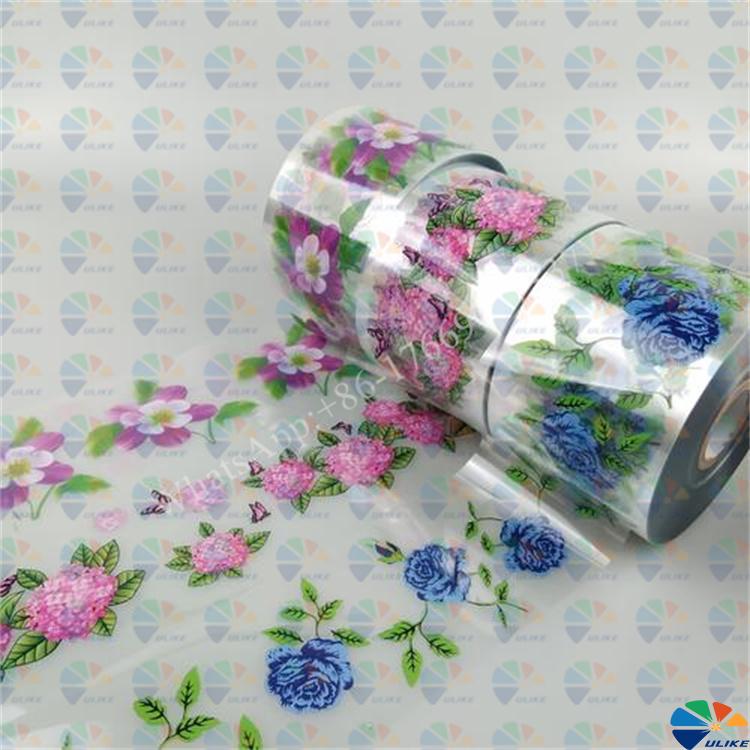Daily thermal transfer film
Daily thermal transfer film
1-What is daily
thermal transfer film?
Daily thermal transfer film is to transfer the pattern of the thermal transfer film to the surface of the items needed in daily life through the heating and pressurization of the thermal transfer machine.
2-The structure of daily thermal transfer film
Generally, it is composed of four layers: base layer, release layer, ink layer, and glue layer.
1. Base layer: that is, the blank thermal transfer film, which is the carrier of the following three layers.
2. Release layer: It is a layer of release coated on the base layer. It will remain solid at room temperature. When it is at a certain temperature, it can melt and quickly separate from the base film without sticking to other substances.
3. Ink layer: This layer is the root of the beauty of the pattern of thermal transfer products. The key lies in the selection and matching of thermal transfer inks.
4. Adhesive layer: It is a hot melt glue. When it is at a certain temperature, it can adhere the pattern to the surface of the substrate and stick for a long time without fading.
3-Two characteristics of daily thermal transfer film
A. Diverse printing patterns and saturated colors
Daily thermal transfer film allows customers to print various patterns on the thermal transfer film. The patterns printed on the surface of the product are bright and saturated in color, and can improve the product grade and increase the value of the product.
B. Diverse applicable materials and wide application range
It is suitable for various plastics, coated wood, metal and other products on flat and curved surfaces of irregular daily necessities, and its application range is very wide and can be seen everywhere in life. For example, most of the patterns on the surface of plastic buckets that are often used in life are made of thermal transfer printing film.
4 - Scope of application of daily thermal transfer film
It can not only be transferred on daily necessities made of plastic materials, but also on special materials such as metal, glass, and wood. For example, girls' makeup combs, electric toothbrushes, cartoon plastic basins, children's mouthwash cups, cute pen holders, sealed jars, metal aluminum thermos cups, insulated lunch boxes, household buckets, and trash cans.

![af]() Afrikaans
Afrikaans![sq]() Albanian
Albanian![am]() Amharic
Amharic![ar]() Arabic
Arabic![fr]() French
French![es]() Spanish
Spanish![ru]() Russian
Russian![de]() German
German![hy]() Armenian
Armenian![it]() Italian
Italian![ja]() Japanese
Japanese![ko]() Korean
Korean![pt]() Portuguese
Portuguese![hi]() Hindi
Hindi![az]() Azerbaijani
Azerbaijani![ro]() Romanian
Romanian![pl]() Polish
Polish![th]() Thai
Thai![el]() Greek
Greek![eu]() Basque
Basque![en]() English
English![zh-CN]() Chinese (Simplified)
Chinese (Simplified)![zh-TW]() Chinese (Traditional)
Chinese (Traditional)![be]() Belarusian
Belarusian![bn]() Bengali
Bengali![bs]() Bosnian
Bosnian![bg]() Bulgarian
Bulgarian![ca]() Catalan
Catalan![ceb]() Cebuano
Cebuano![ny]() Chichewa
Chichewa![co]() Corsican
Corsican![hr]() Croatian
Croatian![cs]() Czech
Czech![da]() Danish
Danish![nl]() Dutch
Dutch![eo]() Esperanto
Esperanto![et]() Estonian
Estonian![tl]() Filipino
Filipino![fi]() Finnish
Finnish![fy]() Frisian
Frisian![gl]() Galician
Galician![ka]() Georgian
Georgian![gu]() Gujarati
Gujarati![ht]() Haitian Creole
Haitian Creole![ha]() Hausa
Hausa![haw]() Hawaiian
Hawaiian![iw]() Hebrew
Hebrew![hmn]() Hmong
Hmong![hu]() Hungarian
Hungarian![is]() Icelandic
Icelandic![ig]() Igbo
Igbo![id]() Indonesian
Indonesian![ga]() Irish
Irish![jw]() Javanese
Javanese![kn]() Kannada
Kannada![kk]() Kazakh
Kazakh![km]() Khmer
Khmer![ku]() Kurdish (Kurmanji)
Kurdish (Kurmanji)![ky]() Kyrgyz
Kyrgyz![lo]() Lao
Lao![la]() Latin
Latin![lv]() Latvian
Latvian![lt]() Lithuanian
Lithuanian![lb]() Luxembourgish
Luxembourgish![mk]() Macedonian
Macedonian![mg]() Malagasy
Malagasy![ms]() Malay
Malay![ml]() Malayalam
Malayalam![mt]() Maltese
Maltese![mi]() Maori
Maori![mr]() Marathi
Marathi![mn]() Mongolian
Mongolian![my]() Myanmar (Burmese)
Myanmar (Burmese)![ne]() Nepali
Nepali![no]() Norwegian
Norwegian![ps]() Pashto
Pashto![fa]() Persian
Persian![pa]() Punjabi
Punjabi![sm]() Samoan
Samoan![gd]() Scottish Gaelic
Scottish Gaelic![sr]() Serbian
Serbian![st]() Sesotho
Sesotho![sn]() Shona
Shona![sd]() Sindhi
Sindhi![si]() Sinhala
Sinhala![sk]() Slovak
Slovak![sl]() Slovenian
Slovenian![so]() Somali
Somali![su]() Sudanese
Sudanese![sw]() Swahili
Swahili![sv]() Swedish
Swedish![tg]() Tajik
Tajik![ta]() Tamil
Tamil![te]() Telugu
Telugu![tr]() Turkish
Turkish![uk]() Ukrainian
Ukrainian![ur]() Urdu
Urdu![uz]() Uzbek
Uzbek![vi]() Vietnamese
Vietnamese![cy]() Welsh
Welsh![xh]() Xhosa
Xhosa![yi]() Yiddish
Yiddish![yo]() Yoruba
Yoruba![zu]() Zulu
Zulu


